How police crackdown triggered angry Ghanaians onto streets in #OccupyJulorbiHouse protest
The three-day #OccupyJulorbiHouse protest was one that was going nowhere, at least if the low-interest levels among netizens in the days leading up to the protest were anything to go by.
That was until the Ghana Police Service decided to crackdown on the few protesters that showed up on day one, creating the needed public sympathy and support for the campaign, culminating in hundreds of Ghanaians pouring onto the streets in defiance of the police.
From 216 mentions of the official hashtag #OccupyJulorbiHouse found on X (formerly Twitter) early on September 21, the dataset collected from Brandwatch, a social media analytics tool, shows the hashtag grew exponentially and appeared in 1.76 million mentions from 720,093 authors between September 21 to 23.
This report has mapped out the online/offline conversations that drove #OccupyJulorbiHouse, highlighting the specific interventions that turned the fortunes of the demonstration around.
- GhanaFact observed a spike in the mention of the hashtag on X from 216 mentions at 7:00 am to 409,922 by the end of day 1 of the protest – September 21, 2023.
- The increased online mentions of #OccupyJulorbiHouse coincides with the police arrest of some protesters on day 1 as shown by the steady rise in mentions from 216 to 2,633 by 9 am.
- On day 2 there were 554,028 mentions and that increased to 797,721 mentions on the last day.
- Geospatial analysis of #OccupyJulorbiHouse showed key contributors to the online campaign were from multiple countries, including Ghana, Canada, the USA, the UK, Indonesia, Australia, Germany, and South Africa.
- An assessment of the top authors who contributed in driving the campaign showed a number of musicians at the forefront of popularising the #OccupyJulorbiHouse hashtag. The X handles of some of the top posters who are also musicians include @Amgmedikalmdk, @kwawkese, @FuseODG, @CrissWaddle, and @Tulenkey. X influencer @gyaigyimii was also among the top posters.
Investigating #OccupyJulorbiHouse
For three consecutive days (September 21 to 23, 2023) protesters defied the heavy rains and poured onto the streets of Accra after many had shared their frustrations online with the state of affairs of the country highlighting, among other things, the high cost of living, rising levels of corruption and the weakening economy.
The hashtag was heavily leveraged by activist groups, Democracy Hub and FixTheCountry. Occupy Julorbi House is a wordplay on Occupy, Jubilee House – Ghana’s seat of government – and ‘Julor Bi’ which means ‘son of a thief’ in Ga – a Ghanaian indigenous language spoken by the people from the Greater Accra Region.
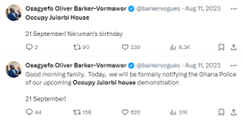
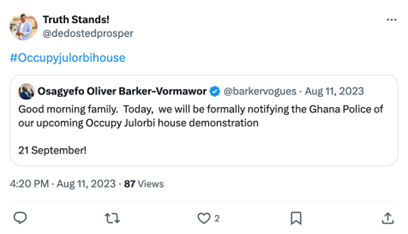
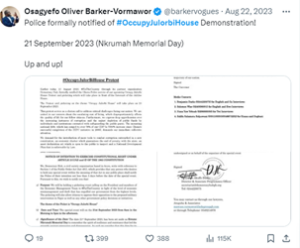
GhanaFact investigations show the phrase “Occupy Julorbi House” first appeared on X on August 11, 2023, and was posted by Oliver Barker-Vormawor (@barkervogues). Another X user, Prospee (@dedostedprosper) reposted the original post, using the hashtag #OccupyJulorbiHouse in his repost.
Oliver Barker-Vormawor is the convenor of #FixTheCountry, a pressure group that emerged from an online campaign on X demanding accountability, good governance and better living standards for Ghanaians. This online campaign evolved into a huge protest on August 4, 2021, when thousands of Ghanaians came out to demonstrate against the government, frustrated by the rising cost of living.
Note: September 21 is marked every year as the birthday of Ghana’s first President, Dr Kwame Nkrumah, while August 4 is observed as “Founders’ Day” a day to celebrate all persons who contributed to Ghana gaining independence from colonial rule.
Data from Brandwatch shows that the hashtag got a bit of traction after Oliver Barker-Vormawor used it in a post on August 21, 2023 – his post had more than 100,000 views and 806 interactions including (likes, reposts and comments).
As of September 20, 2023, the day before the protest, Brandwatch shows that the hashtag was mentioned 2,603 times on X. This figure is considered low which is reflective of the low media coverage of the planned protest. Not even an arrest of some of the protesters on day 1 could get the demonstration coverage on the front pages of some of the popular national newspapers.
Two reasons could potentially explain this: firstly, was it a deliberate media blackout, as was suggested by a social media user who is also a well-known journalist or self-censorship?
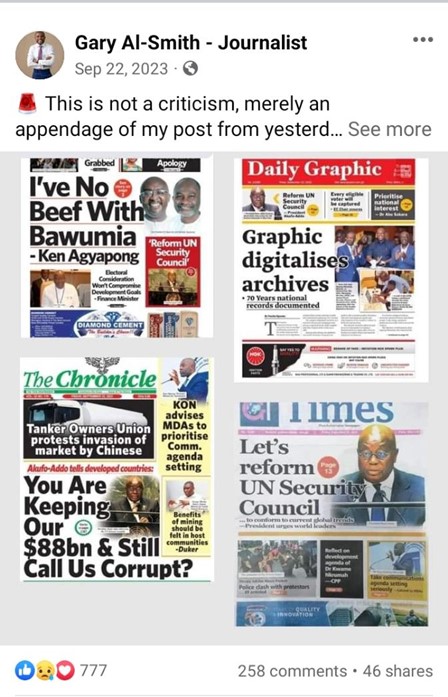
However, over the period of the three-day protest, the hashtag had gathered 1.76 million mentions from 720,093 authors and this raises questions like: what contributed to the sudden spike in online mentions using #OccupyJulorbiHouse; and how did that online usage affect the in-person protest that ensued?
GhanaFact observed a spike in the mention of the hashtag on X from 216 to 409,922 on the first day of the protests, September 21, 2023, and 554,028 mentions on day 2, September 22, 2023.
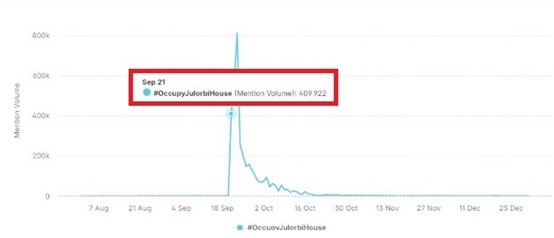
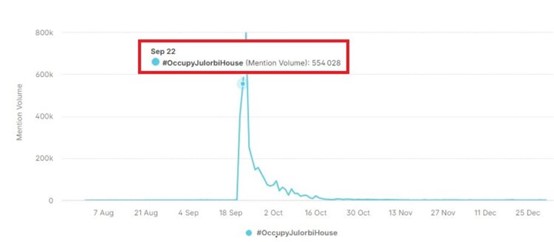
On September 23, 2023, the last day of the protest, the hashtag gathered 797, 721 mentions, before tapering down gradually to 134 mentions as of December 31, 2023.
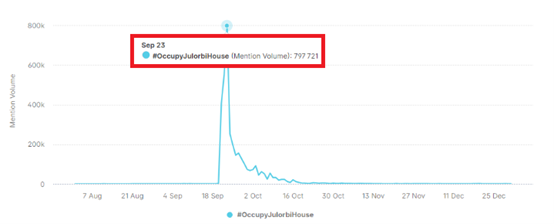
Between August 1, 2023, and December 31, 2023, our checks show #OccupyJulorbiHouse was mentioned 3.63 million times, with 820,003 Unique Authors on X.
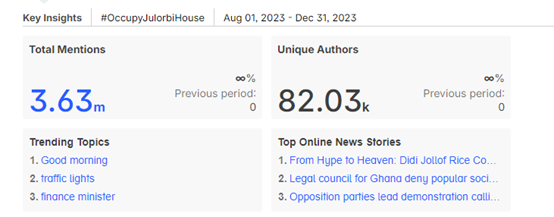
Why the sudden spike in the mention of the hashtag?
In the early hours of September 21, 2023, the hashtag did not gain any traction online until around 9:00 am when there was a sudden shift in momentum in #OccupyJulorbiHouse. Mentions increased from a few hundreds to the thousands.
The team of researchers noticed that from no significant mention of the hashtag around 6:00 am, there were 216 mentions at 7:00 am, which increased to only 366 mentions by 8:00 am. Then the team noticed a sudden jump to 2,633 mentions by 9:00 am and this increased by about threefold an hour later.
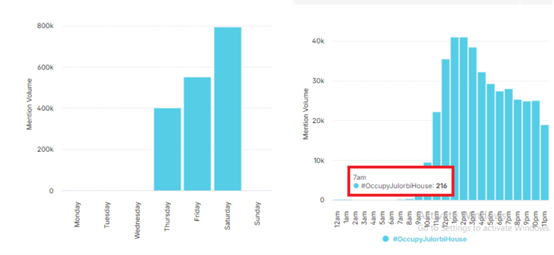
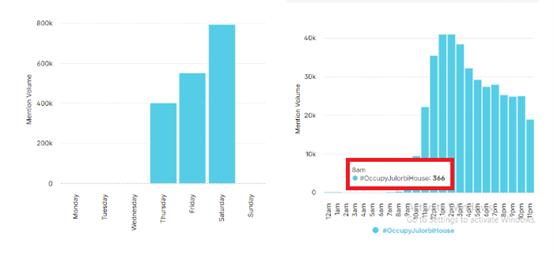
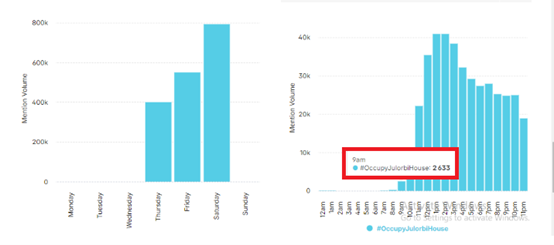
With this context in mind, GhanaFact’s offline monitoring of the protest showed that the increase in online engagements coincided with when the Ghana Police Service decided to arrest a few of the protesters (here, here and here) who showed up together with some media persons who were there to provide coverage. According to the Ghana Police Service, an application filed at the courts to injunct the September 21 protest was enough grounds to arrest the protesters.
This was the catalyst that spurred the online conversation and resultant massive public support.
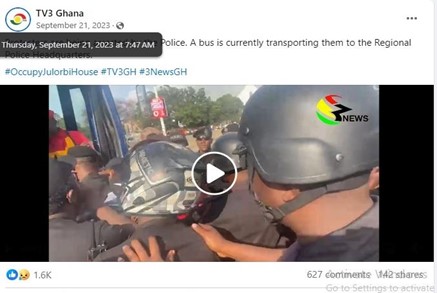
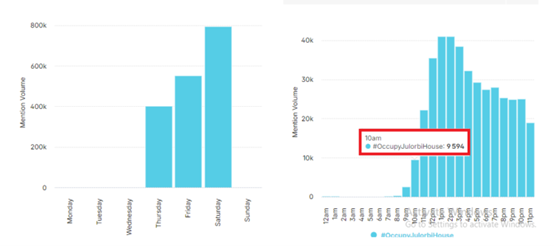
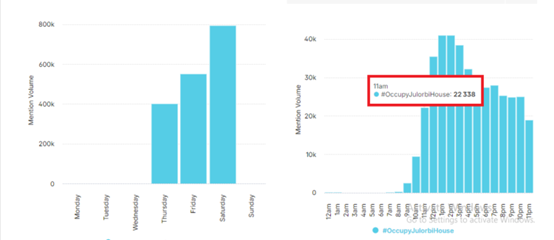
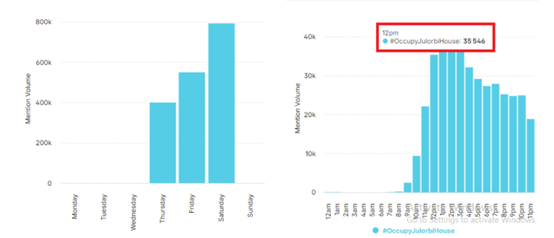
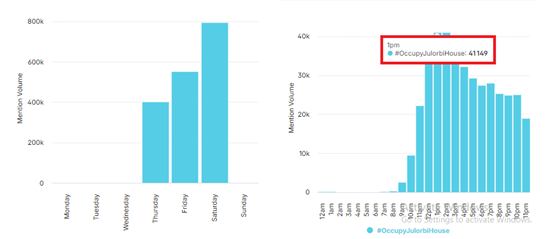
On Brandwwatch, an assessment of the total number of mentions over the three-day period broken down by sentiments and emotions showed overwhelming levels of negative sentiments, with the emotions ranging from anger, disgust, fear, joy and sadness.
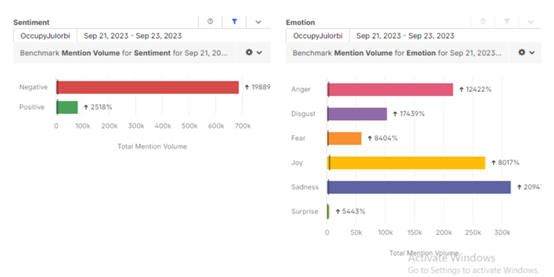
Subsequently, several notable personalities joined in the conversation online and expressed their willingness to join the protesters. These included a private legal practitioner – Martin Kpebu, Ghanaian musician – Livingstone Etse Satekla (Stonebwoy), sports journalist – Gary Al-Smith, social media influencer – Joshua Buernortey Boye-Doe (Kaly Jay), socialite – Efia Odo, actor – John Dumelo, comedian – SDK Dele, singer – Kelvyn Boy and singer – Efya Nokturnal among others.
Day 1 of the protest
On day 1 of the protest, forty-nine (49) protesters were arrested around 8 am by the police, with videos and pictures of the arrest being widely shared on mainstream and new media.
One emerging narrative online was the seeming high-handedness of the police during the arrest of the protesters and some journalists, with videos and photos of the police allegedly manhandling the protesters surfacing online.
A statement issued by the Police sought to deny the arrest of a BBC journalist, a claim immediately rebuffed by the Ghana Journalists Association (GJA) who further indicated in a statement that not only had the police arrested a BBC journalist, but also others from Agence France-Presse (AFP) and the Associated Press (AP).
By late morning, some social media users had begun a campaign to free the arrested protesters. This led to the introduction of the hashtag, #freetheprotesters which had a total of 1786 shares at the time of putting together the report. Some popular celebrities followed suit by posting their disappointments online (1,2,3,4,5,6,7,8) and this had a great impact on participation on Day Two of the protest.
X mentions of the police rose from 36 at 8:00 am to 12,000 around 2:00 pm, on the first day. Some social media users tried to identify the police officers (1, 2) seen in viral videos allegedly manhandling the protesters.
Day 2 of the protest
Although the second day of the protest was relatively peaceful compared to day 1, the die had been cast. Different actors including celebrities, influencers with large social media following and mainstream media organisations were now very much interested in the protest – playing out both online and offline.
Some popular celebrities (1, 2, 3, 4) joined the protest on the ground and invited other citizens at home to join the protest and fight for a common cause. Towards the end of the day, there was a huge rainfall in various parts of the capital, including the protest grounds which many thought was a good test of the protesters’ resilience (here and here). The conversations gathered 11,000 out of the 558,000 posts on the second day of the protest.
Day 3 of the protest
The protest continued on the third day, with different issues about the country’s pace of development being highlighted in online conversations. On social media, concerns were being raised about the country’s deteriorating road infrastructure, high levels of unemployment, weak education system and the refusal of key government actors to acknowledge the protest (here).
Then a document started circulating online showing a long list of politicians, MPs, heads of institutions and their associates who benefited from Ghana Education Trust Fund (GETFund) scholarships – a scheme originally meant for brilliant but needy students.
GhanaFact later discovered the document was from a 2018 audit report produced by GETFund and this opened up a new conversation about corruption, cronyism, conflict of interest, abuse of power and Ghana’s rigged economic system.
Solidarity/Counter-protest in the West
The online buzz the protest generated caught the attention of international media outlets including Reuters, DW Africa, BBC News, and Al Jazeera and subsequently won the support of some Ghanaians living in the diaspora.
On September 29, 2023, a section of Ghanaians living in the United Kingdom (UK) staged a replica of the #OccupyJulorbiHouse protest in front of the Ghana High Commission in the UK, demanding better living conditions for their families back home in Ghana.
The protesters wielding placards with various inscriptions were demanding the resignation of the President while the British police were invited to ensure peace since a counter-protest group had also mobilised to show support for the government.
On September 30, 2023, a group of Ghanaians also took to the streets of the German city of Berlin to hold their version of the protest, waving placards that demanded action on the key planks of the protest that took place back home.
In the case of New York, protesters on October 7 camped in front of the Ghana Embassy in New York. Some of them carried placards demanding a turnaround in the socioeconomic fortunes and governance direction of the country.
They also had some strong messages for the government regarding the state of the nation on various issues including corruption.
Counter-protest and counter-hashtag
In the heat of the online/offline conversations, a counter-hashtag #OccupyJubileeHouse also started trending on X, running concurrently with #OccupyJulorbiHouse. Critics of the hashtag and the ensuing protest had raised issues that the popular #OccupyJulorbiHouse was insulting and demeaning of the high office of the Presidency.
Some netizens used the counter-hashtag #OccupyJubileeHouse in their posts online together with other major media platforms, including TV3, Daily Graphic, Asaase Radio, and JoyNews.
Key topics highlighted by #OccupyJulorbiHouse protesters
One of the main concerns shared online had to do with the effects of illegal mining activities on the country’s water bodies and the general deterioration of the living conditions of Ghanaians. (1,2,3,4).
“I’ve seen the Pra. I’ve seen the Ankobra. In Prestea they advise us not to use the tap water to cook or drink it. Illegal mining activities are killing this country. But this government is pretending that the issue has been solved. That’s why I’m protesting. #OccupyJulorbiHouse” one online protester published on X.
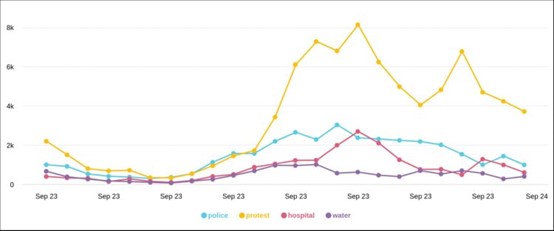
Meanwhile many expressed worry about the high cost of food, increases in the price of sachet water (1,2) and transportation (1), while others were concerned about high cost of credit for small businesses (1).
Other netizens raised issues with the poor state of healthcare and cost of medicines (1,2,3). “Ghanaians deserve better! We shouldn’t have to protest for basic needs like access to healthcare to be prioritized over building a cathedral! #OccupyJulorbiHouse” one user posted on X.
Some key hospitals that topped the list of complaints were Korle Bu Teaching (1,2,3) Hospital and the La General Hospital (1,2,3,4) which is yet to be constructed after demolishing the old structure (1,2,3).
The youth who formed a majority of the protesters were also angry with comments by a politician who described young people as lazy (1,2,3,4).
Top Authors
In analysing the top authors who participated in the mention of the popular hashtag #OccupyJulorbiHouse during the three-day demonstration, GhanaFact found that males contributed 71% to the conversation and females contributed 29% to the virality.
Using Brandwatch, GhanaFact identified the following top tweeters and their contribution to amplifying the hashtag. @Amgmedikalmdk, @kwawkese, @FuseODG, @SavvyRinu, @Mbahdeyforyou, @fynnba_, @gyaigyimii, @CrissWaddle, @Tulenkey and @Flavaflavwife constituted a group of music artistes, comedians, media personalities and social media influencers with large followings who drove the conversation on X.
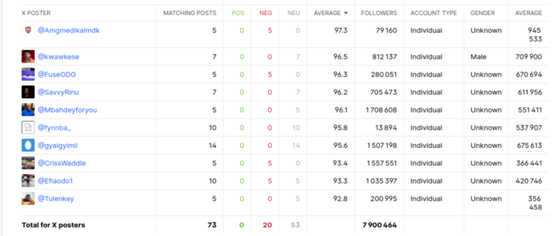
For instance, Medikal, a popular Ghanaian rapper was the first among the top authors using the hashtag coined for the protest. Medikal at the time had 115, 200 followers on X and was identified to have mentioned the hashtag on five occasions. However, these 5 tweets had reached 945,534 people on X.
Kwaw Kese, a Ghanaian musician with 822, 500k followers was identified to have mentioned the hashtag 6 times but had reached 709,900 X users.
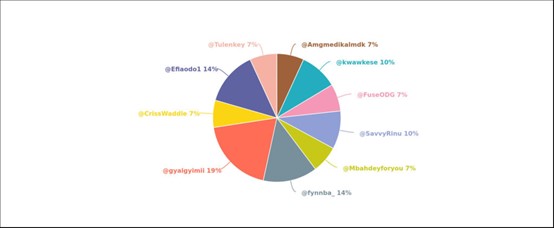
The handle @Flavaflavwife which made 15 mentions had an average reach of 92.7% and @gyaigyimii with 13 mentions had a 95.6% on average.
Geospatial Analysis of the #OccupyJulorbiHouse X/Twitter Campaign
The #OccupyJulorbiHouse protest in Ghana got significant attention on various social media platforms, most notably X. Employing the advanced Brandwatch social media analytics tool enabled us to conduct a comprehensive geographical examination, providing insights into the hashtag’s prevalence and the global impact of social media discussions leading up to the protest.
Our analysis revealed the extensive reach of the activity associated with #OccupyJulorbiHouse, transcending international boundaries. Key contributors to the movement were identified in various countries, including Ghana, Canada, the USA, the UK, Indonesia, Australia, Germany, and South Africa.
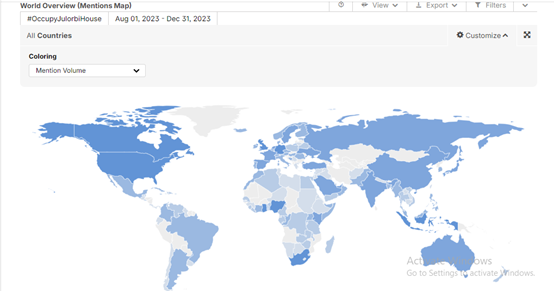
Meanwhile, GhanaFact observed that some protesters even though present in Ghana, had their X geolocation set to countries outside the borders of Ghana. Examples of such X users identified are @gyaigyimi and @Dr Sneaker Nyame.
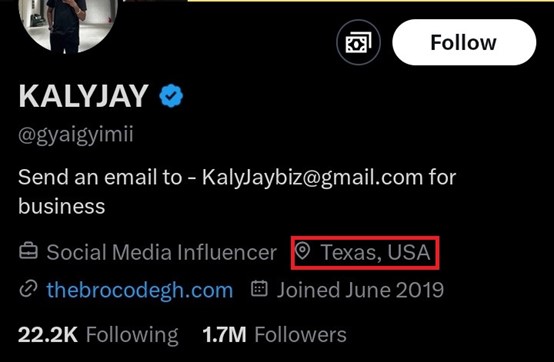
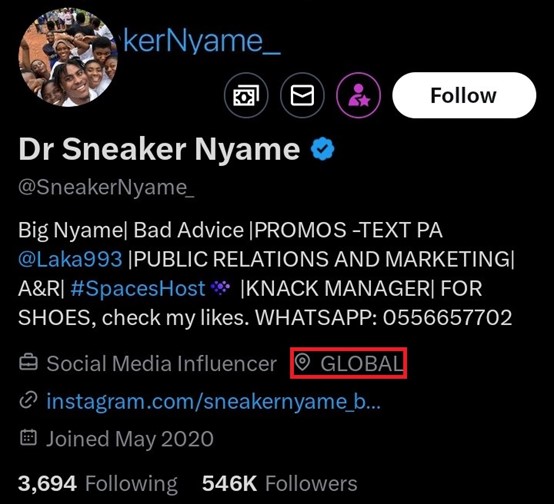
Country-specific Mentions
Ghana emerged as the epicentre of the demonstration, boasting a commanding presence on X with a remarkable 1,000,000 mentions. This constituted a staggering 78% of the overall mentions of #OccupyJulorbiHouse, highlighting the profound impact and resonance of the movement within the Ghanaian digital landscape.
This was followed by the United States of America with about 200,000 mentions, indicating a moderate but influential level of participation. The United Kingdom had about 40,000 mentions and emerged as a significant country in the social media dialogue surrounding the #OccupyJulorbiHouse protest after a copycat protest was also held at the premises of the Ghana High Commission in the UK.
Canada also participated in the discourse and generated 21,000 mentions demonstrating significant involvement from the Canadian X community, while Indonesia had 45,000 mentions showing its unique contribution to the global conversation. Australia also has about 7,000 mentions reflecting some interest in the #OccupyJulorbiHouse movement.
Germany contributed to the discourse with 15,000 mentions showing a level of involvement in the conversation. Lastly, South Africa actively participated in the discussion, amassing 23,000 mentions related to the #OccupyJulorbiHouse demonstration.
The geographical analysis of #OccupyJulorbiHouse’s X activity underscores the global resonance of the protest. With a formidable presence in Ghana and substantial engagement from countries such as Canada, the USA, the UK, Australia, Germany, Indonesia, and South Africa, the social media discourse played a pivotal role in amplifying the hashtag on the global stage.
Conclusion
Social media has proven to be an effective mobilisation tool for activists. Like #EndSarsNow in Nigeria, #OccupyJulorbiHouse in Ghana was an attempt to rally citizens to demand good governance and accountability, despite the stark differences in intensity and violence.
Hashtag activism is not new to Ghana, and long before #OccupyJulorbiHouse, there was the #DumsorMustStop protest in 2015 – an online conversation about Ghana’s crippling power crisis that ended up in a massive demonstration on the streets of Accra. There have also been other social media movements – #FixTheCountry and #OccupyFlagStaffHouse – that have dominated the public sphere and held the government’s feet to the fire, although with varying degrees of success.
But #OccupyJulorbiHouse is different. It presents a unique case study of how not to treat social media activism lest you risk giving it momentum – awakening the docile masses already irked by the dysfunction in government and looking for an outlet to vent.
By GhanaFact
Used with permission of the publishers.

